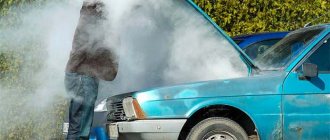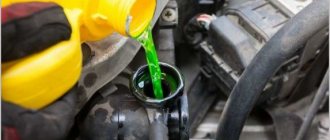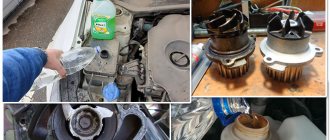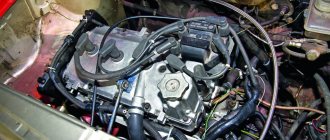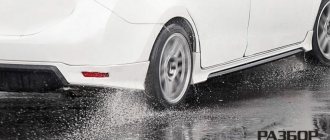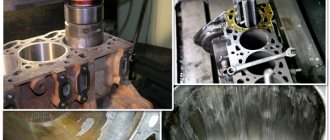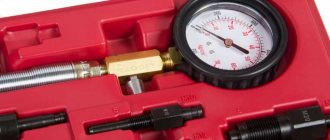Is it possible to dilute antifreeze with water?
Car enthusiasts are often faced with a situation where they need to add antifreeze to the cooling system, but they don’t have the necessary liquid on hand, and the nearest store is not close. The first thought that comes to mind is to add regular water. But before you do this, you need to know whether it is suitable for these purposes.
When and why to dilute
Since antifreeze contains a significant portion of water, nothing bad will happen when it is added. In this case, the concentration of antifreeze will simply decrease and the more water you add, the worse its properties will be. However, there are situations when it is recommended to dilute the coolant. This has to be done, as a rule, if the antifreeze has been subjected to boiling, during which part of the water has evaporated and the liquid in the cooling system has become more concentrated.
Mixing in summer and winter
Basically, water has to be added to antifreeze in the summer, since the liquid evaporates more actively. Add water in accordance with the following recommendations:
- if initially the engine cooling system was filled with a concentrate that had not previously been diluted, and about 100–250 ml of antifreeze was used, then you can safely add distilled water to it;
- If there is significant evaporation of antifreeze, it is better to bring the level to normal using the original composition. If the brand of liquid filled is unknown, then distillate should be used for dilution, and the antifreeze should be replaced in the fall.
If the antifreeze has evaporated in large quantities, then it is better to bring it up to normal with the original composition
In winter, adding water in any quantity is prohibited. Otherwise, there is a high probability of problems with the cooling system or engine as a result of freezing, which will lead to expensive repairs.
When using antifreeze in a cooling system, its minimum freezing point should be -25 °C, and when adding water this figure will decrease.
What kind of water is suitable
The ideal option for diluting antifreeze is distillate. It does not contain calcium and magnesium. It is not worth using ordinary water for the purposes under consideration, since it negatively affects the components of the cooling system. If you use such water to dilute antifreeze, it may precipitate. Tap water can be filled only if the hardness level is low - no more than 5 mEq/l. If it is not possible to determine the hardness, then water and antifreeze should be mixed in small quantities and if there is no sediment, it can be added to the system.
It is best to use distilled water to add to antifreeze.
Manufacturer's recommendations
If you follow the recommendations of antifreeze manufacturers, they prohibit adding water to the product in question. This is explained by the fact that antifreeze initially contains various additives that extend the life of the cooling system, lubricating the necessary components and providing better engine cooling. Water will only worsen these indicators. While domestic cars used to use water without any concerns, the cooling system of modern cars is made of aluminum alloys, which are susceptible to corrosion from water with a high hardness index. As a result, the radiator becomes clogged over time, which will lead to constant overheating of the engine.
Water suitable for use
The liquid that flows from our taps, or even filtered ones, usually contains too many minerals. For example, calcium and magnesium contained in the fluid form sediment around the parts of the cooling system and the engine itself. Such residues can reach very high temperatures. That is why, regardless of which manufacturer of antifreeze is used, what its composition is, whether it is red or green in color, you must use only distilled water
.
Such water has clear advantages not only due to the fact that all the minerals have been separated during the condensation process. It is also very important that its freezing temperature is much lower, and, therefore, the effect of use will be much better.
Procedure for diluting antifreeze with water
Antifreeze is diluted with water in different ways, depending on the situation and the product purchased.
By car
To mix the liquids in question directly on the vehicle, you will first need to determine the freezing point of the antifreeze using a hydrometer. With its help, we collect some of the liquid from the expansion tank. We compare the device readings with the temperature on the antifreeze canister. If there is no container at hand, then you should focus on the average freezing temperature of the substance -40C. Therefore, water should be added until the indicator reaches the desired value.
To determine the freezing point of antifreeze you will need a hydrometer
In containers
Automotive stores offer antifreeze in two versions:
- ready for use;
- in the form of a concentrate.
If everything is simple with the ready-made product - you bought it and poured it in, then with the concentrate you will have to tinker a little. To dilute it you will need a distillate and a suitable container. The volume of the diluted substance must correspond to the volume of heat removal fluid in your car’s system.
Water deal: what happens if you mix poured antifreeze with water and a direct answer to the question
We open the hood and inspect the tanks.
At one point we notice that in the cooling system tank the level of the composition has dropped below the mark or level marked as Low. Immediately there is confusion about what to pour: antifreeze or liquid from the tap. Experts warn that there is no need to rush; you need to look through the factory booklet for information about the filled emulsion and ways to restore its level. Then the question of what will happen if you mix antifreeze with water will disappear by itself. We will present multilateral situations when it is possible to add natural chemical liquid and when it is not.
A little fluid was lost
Let's say the nominal level in the tank has shifted down by 100...300 milliliters. In this case, you can confidently fill in water and not worry about the condition of the system. The balance of additives will not change, since the evaporated liquid is just water. It's worth knowing:
- Antifreeze is half water.
- Only distilled composition can be added.
- Ordinary water cannot be added due to the fact that the outcome of the interaction of the natural chemical composition with coolant additives is unknown.
- The solution from the tap is harsh and can lead to corrosion of the cooling system passages.
For your information. Many manufacturers sell concentrates. These products are precisely dissolved with distilled water. The proportions depend on the desired freezing temperature and are indicated on the packaging. The nominal ratio of diluted substances for temperate climates is 1:1.
Coolant is missing in large quantities
The best option would be to add ready-made antifreeze or diluted concentrate. If a leakage situation occurs far from points of sale, and it’s summer outside, then you can safely pour the distilled composition. As a last resort, filtered water will do.
If diluted with a large amount of water, the coolant must be replaced. Moreover, this should be done before the onset of the first cold weather. Naturally, in winter it is prohibited to resort to excessive dilution of the coolant. After all, it may freeze and the engine will require partial repairs.
Diluting antifreeze in emergency situations
Sometimes it happens that coolant needs to be added on the road due to a leak, but it is not in stock. As a rule, there is no distilled water either. Therefore, you can use boiled or filtered water to fill the system. If there is a large leak, water can be added in any quantity, but only in the summer. At the end of the trip, it is necessary to drain the liquid from the system and fill it with fresh antifreeze.
In the event of an antifreeze leak on the road, water can be added to the cooling system
Diluting antifreeze concentrate
Antifreeze concentrate is a substance that does not contain distilled water. The remaining components, such as dye, additives and ethylene glycol, are present in full.
Antifreeze concentrate is a substance that does not contain distilled water.
In order for antifreeze to perform its functions and not have to be poured out due to improper mixing, the correct proportions must be maintained. The procedure itself is not complicated and consists of mixing the concentrate with distilled water according to the table values.
Table: proportions of water and antifreeze concentrate
| Water percentage | Concentrate percentage | Freezing threshold, °C | Boiling threshold, °C |
| 87,5% | 12,5% | -7 | 100 |
| 75% | 25% | -15 | 100 |
| 50% | 50% | -40; -45 | +130; +140 |
| 40% | 60% | -50; -60 | +150; +160 |
| 25% | 75% | -70 | +170 |
Breeding rules
For dilution, use distilled water, sold in automotive or hardware stores. Using tap, well or spring water is fraught with trouble. Microelements contained in water quickly settle on the walls of the unit, which leads to a decrease in the cooling effect.
This is interesting: Which putty for cars is better
If a manufacturer claims that its products can be diluted with tap water, then a small experiment is conducted to check. Liquid, tap water and solution are poured into a transparent container. The result is checked after two days. If the solution is cloudy or there is sediment at the bottom, then this composition must be diluted with distillate.
If antifreeze is used in heating systems, then its main quality is resistance to boiling over. To prevent the liquid from crossing the vaporization threshold, the antifreeze concentrate must be diluted at a maximum temperature of 95 ° C.
If the proportions are not met, then ethylene glycol will undergo intense evaporation, not water. As a result, the entire coolant will have to be replaced.
In what proportion should water and concentrated liquid be mixed? For example, if you take them one part at a time, the freezing threshold of such a solution is -45 °C, and boiling occurs in the range of 130 - 140 °C.
The table of proportions clearly shows the dilution of antifreeze concentrate.
| Solution concentration, % | Proportion | Crystallization limit, °C | Vaporization limit, °C |
| concentrate – water | |||
| 13 — 87 | -7 | +100 | |
| 25 — 75 | 1:3 | -15 | +100 |
| 50 — 50 | 1:1 | -45 | +135 |
| 60 — 40 | 3:2 | -60 | +155 |
| 75 — 25 | 3:1 | -70 | +170 |
The table displays the manufacturers' requirements for diluting antifreeze concentrate. With increased water content, properties are lost.
